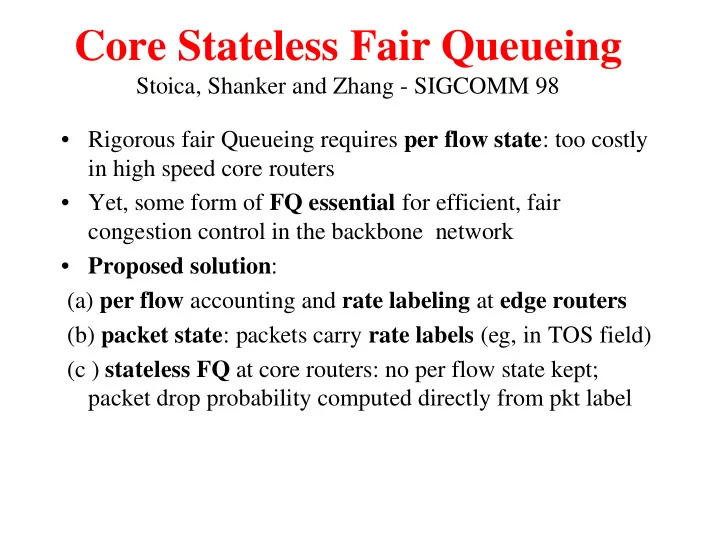

Core Stateless Fair Queueing Stoica, Shanker and Zhang - SIGCOMM 98 • Rigorous fair Queueing requires per flow state : too costly in high speed core routers • Yet, some form of FQ essential for efficient, fair congestion control in the backbone network • Proposed solution : (a) per flow accounting and rate labeling at edge routers (b) packet state : packets carry rate labels (eg, in TOS field) (c ) stateless FQ at core routers: no per flow state kept; packet drop probability computed directly from pkt label
Key Elements of CSFQ • Edge router estimates current rate r(i) of each flow and stamps it in IP header (eg, TOS field) • Flow rate value adjusted as pkt travels through various bottlenecks in the backbone • Core router estimates max/min fair share on its links based on aggregate traffic measurements • Core router probabilistically drops packets in a flow which exceeds fair share
Fair Share Computation at Router • Assume N flows arrive at core router • Each flow rate r(i) is stamped in header • Max-Min fair operation: (a) all bottlenecked flows get “ fair share ” rate “ a “ (the excess rate packets are dropped) (b) non-bottlenecked flows are granted their full rate Thus, at full trunk utilization: Sum (over i = 1..N) of min{ r(i,t), a(t) } = C where C = trunk capacity
Fair Share Computation (cont) If all r(i) are known at the router, fair share a can be easily computed: (a) try an arbitrary fair share threshold a(0) (b) from “fair share” formula compute the resulting link throughput R (c) compute new value a(1) = C/R (d) go back to (b) and iterate until a(n) converges to fixed point
Probabilistic Dropping at Router • If aggregate arrival rate A < C, no pkt is dropped • If A > C (ie, congested link): (a) bottlenecked flow ( ie, r(i,t) > a(t)): drop the fraction of “bits” above the fair share, ie (r(i,t) -a(t))/r(i,t) (b) non-bottlenecked flow: no dropping Equivalently: packet drop probability = max (0,1- a(t)/r(i,t)) • adjust rate label value: r(i,t) <= min (r(i, t), a(t))
Implementation details (cont) (a) flow arrival rate at edge router computed with exp avg (b) fair share computation at core router : measure aggregate arrival rate A(t) using exp averaging If router is congested (ie, A(t) >C), then: measure (exp avg) the fraction F of bits currently accepted ie, F(t) = current acceptance rate Assume F is a linear function of a (in reality concave function). Then: New fair share value: a(new) = a(old) C/F(t)
More details.. • Occasionally, router buffer overflows: • then, decrease a(t) by 1% • Never increase a(t) by more than 25% • Link is considered uncongested if occupancy < 50% of buffer capacity • Weighted CSFQ option: if w(i) is the weight of flow i, then: r(i) <= r(i)/w(i)
Simulation Experiments • FIFO • RED (FIFO + Random Early Detection) • FRED (Flow Random Early Drop, SIGCOMM 97): extension of RED to improve fairness; it keeps state of flows which have one or more pkts in queue; it preferentially drops pkts from flows with large queues • DRR (Deficit Round Robin): per flow queueing ; drops packets from largest queue
Single Congested Link Experiment 10 Mbps congested link shared by N flows (a) 32 UDP flows with linearly increasing rates (b) single “ill behaved” UDP flow; 31 TCP flows (c) single TCP flow; 31 “ill behaved” UDP flows
Edge and Core Routers
(a) linear rate UDPs; (b) single UDP + 31 TCPs
Single TCP competing with up to 31 UDPs
Multiple congested links
Coexistence of TCP and Receiver Layered Multicast: DRR
Coexistence of TCP and Receiver Layered Multicast: CSFQ
Coexistence of TCP and Receiver Layered Multicast: RED
Conclusions • CSFQ does not require per flow state within the core • CSFQ performance comparable to DRR (which however requires per flow state) • superior to FRED (“partial” per flow state) • much better than RED, FIFO (no per flow state) • large latency and propagation delay effects (such as on a cross country connection or on a satellite segment) still to be explored • use of TOS field (ie,packet state) potentially controversial
Recommend
More recommend